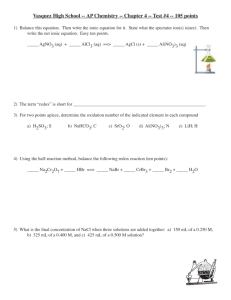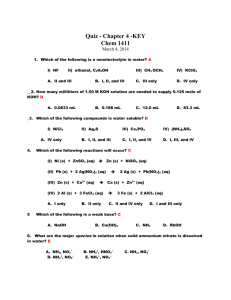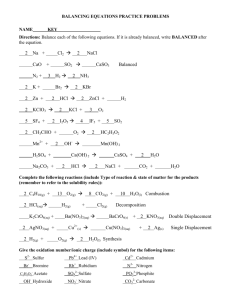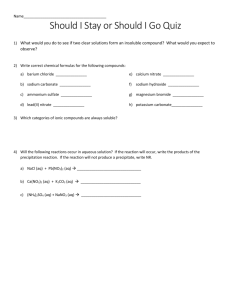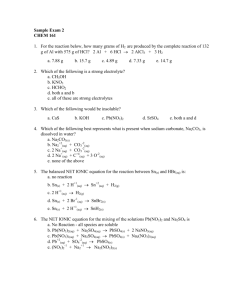Steps for balancing a chemical equation X
advertisement
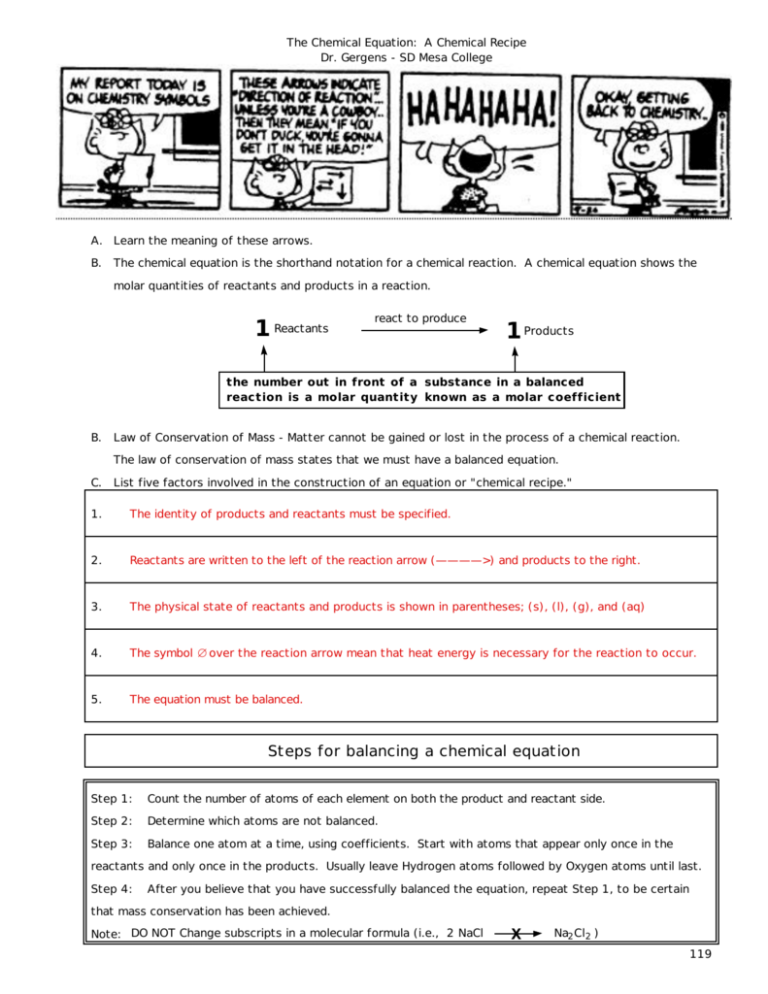
The Chemical Equation: A Chemical Recipe Dr. Gergens - SD Mesa College A. Learn the meaning of these arrows. B. The chemical equation is the shorthand notation for a chemical reaction. A chemical equation shows the molar quantities of reactants and products in a reaction. 1 Reactants react to produce 1Products the number out in front of a substance in a balanced reaction is a molar quantity known as a molar coefficient B. Law of Conservation of Mass - Matter cannot be gained or lost in the process of a chemical reaction. The law of conservation of mass states that we must have a balanced equation. C. List five factors involved in the construction of an equation or "chemical recipe." 1. The identity of products and reactants must be specified. 2. Reactants are written to the left of the reaction arrow (————>) and products to the right. 3. The physical state of reactants and products is shown in parentheses; (s), (l), (g), and (aq) 4. The symbol ∆ over the reaction arrow mean that heat energy is necessary for the reaction to occur. 5. The equation must be balanced. Steps for balancing a chemical equation Step 1: Count the number of atoms of each element on both the product and reactant side. Step 2: Determine which atoms are not balanced. Step 3: Balance one atom at a time, using coefficients. Start with atoms that appear only once in the reactants and only once in the products. Usually leave Hydrogen atoms followed by Oxygen atoms until last. Step 4: After you believe that you have successfully balanced the equation, repeat Step 1, to be certain that mass conservation has been achieved. Note: DO NOT Change subscripts in a molecular formula (i.e., 2 NaCl X Na2 Cl 2 ) 119 Double Displacement Reactions Demonstration Dr. Gergens - SD Mesa College Using the solubility rules for ionic salts (see your periodic table, front cover), predict whether mixing the two aqueous ionic salts (or aqueous strong acid) will produced an insoluble precipitate. CuSO4 (aq) NaNO3 (aq) HCl (aq) all soluble all soluble copper (II) sulfate CuSO4 (aq) NaNO3 (aq) sodium nitrate hydrochloric acid AgNO3 (aq) all soluble Ag2SO4 (s) CuCO3 (s) silver (I) sulfate copper (II) carbonate all soluble all soluble AgCl (s) HCl (aq) Na2 CO3 (aq) H2O(l)+ CO 2 (g) silver (I) chlroide Ag2CO3 (s) AgNO3 (aq) silver (I) nitrate silver (I) carbonate sodium carbonate Na2 CO3 (aq) A. CuSO4 (aq) + NaNO3 (aq) ______> No Reaction (NR) B. CuSO4 (aq) + HCl (aq) ______> NR C. 1 CuSO4 (aq) D. CuSO4 (aq) E. NaNO3 (aq) F. 1 HCl (aq) + G. 2 HCl (aq) + H. NaNO3 (aq) + I. NaNO3 (aq) + + + 2 AgNO3 (aq) Na2 CO3 (aq) + HCl (aq) 1 AgNO3 (aq) 1 Na2 CO3 (aq) AgNO3 (aq) Na2 CO3 (aq) ______> 1 Ag2 SO4 (s) ______> NR ______> NR ______> 1 AgCl (s) ______> ______> ______> + 1 Cu(NO3)2 (aq) + 1 NaNO3 (aq) 2 NaCl (aq) + 1 CO2 (g) + 1 H2 O(l) NR NR BALANCING PRACTICE Dr. Gergens - SD Mesa College a. b. c. d. 1. 2. 3. Balance each of the following equations by adjusting the coefficients in front of the chemical formulas. List the physical state of each compound. Determine the driving force for each reaction. Classify each reaction in as many ways as possible. 2 AgNO3 (aq) ______> reduced silver (I) nitrate Cu (s) + oxidized copper metal 2 Al (s) + oxidized aluminum metal Na2 CO3 (aq) + sodium carbonate 4. 5. 3 Fe (s) oxidized iron metal + 3 S (s) reduced sulfur nonmetal ______> CaCl 2 (aq) ______> ______> Al 2 S 3 2 Ag (s) silver metal copper (II) nitrate CaCO3 (s) Transfer of Electrons Single Replacement Redox Transfer of Electrons Combination (Synthesis) Redox (s) + 2 NaCl (aq) sodium chloride 2 FeCl 3 (s) Precipitation of CaCO3 Double Replacement Transfer of Electrons Combination (Synthesis) Redox iron (III) chloride Ba 3 (PO4 )2 (s) + barium phoshpate barium chloride sodium phosphate + calcium carbonate ______> 3 Cl2 (g) reduced chlorine gas nonmetal 3 BaCl2 (aq) (aq) aluminum sulfide calcium chloride 2 Na3 PO4 (aq) + Cu(NO3 )2 6 NaCl (aq) Precipitation of Ba3 (PO4 )2 sodium chloride Double Replacement 6. 2 NaOH (aq) + CuSO4 (aq) ______> Na2 SO4 (aq) + 7. Mg(OH)2 (s) + H2 SO4 (aq) ______> MgSO 4 (aq) + 2 H2 O (l) Water Formation Double Replacement Acid-Base Reaction 8. 2 Al (s) oxidized + 6 HCl (aq) reduced ______> 2 AlCl 3 (aq) + 3 H2 (g) Hydrogen Gas Formation Single Replacement Redox 9. 3 Mg (s) oxidized + 2 H3 PO4 (aq) reduced ______> Mg 3 (PO4 )2 (s) 10. Br 2 (l) reduced + 2 CuI (aq) oxidized ______> 2 CuBr (aq) + I 2 (s) 11. 3 NaOH (aq) + FeCl 3 (aq) ______> 3 NaCl + Fe(OH)3 (s) Precipitation of Fe(OH)3 Double Replacement 12. 2 KBr Pb(NO3 )2 (aq) ______> + PbBr 2 (s) Precipitation of PbBr 2 Double Replacement Precipitation of Al 2 (SO4 )3 Double Replacement 13. 14. 15. (aq) + (aq) 2 KNO3 (aq) Cu(OH)2 (s) Precipitation of Cu(OH)2 Double Replacement + 3 H2 (g) Mg 3 (PO4 )2 ppt & H 2 Gas Single Replacement Redox Transfer of Electrons Single Replacement Redox 2 AlCl 3 (aq) + 3 H2 SO4 (aq) ______> Al 2 (SO4 )3 (s) + 6 HCl Al 2 (SO4 )3 (aq) + 3 BaCl2 (aq) ______> 3 BaSO4 (s) + 2 AlCl 3 (aq) Precipitation of BaSO4 Double Replacement Cd(NO3 )2 (aq) H2 S ______> CdS (s) + 2 HNO3 (aq) Precipitation of CdS Double Replacement + (l) (aq) 116 DOUBLE REPLACEMENT REACTIONS AND PREDICTIONS PRACTICE Dr. Gergens - Mesa College a. b. c. Complete and balance each of the following equations for double replacement reactions. List the physical state of each compound. Determine the driving force for each reaction. + AgNO3 (aq) ______> NaNO3 (aq) + AgCl BaCl 2 (aq) + H2 SO4 (aq) ______> BaSO4 (s) + 2 HCl 3. NaOH (aq) + HCl ______> NaCl + H2 O (l) Water Formation 4. Na2 CO3 (aq) + 2 HCl ______> 2 NaCl + H2 O (l) + 5. H2 SO4 (aq) + 2 NaOH (aq) ______> 2 H2 O (l) + Na2 SO4 (aq) 6. FeCl 3 (aq) + 3 KOH (aq) ______> Fe(OH)3 (s) + 3 KCl (aq) Precipitation of Fe(OH)3 7. Na2 SO3 (aq) + 2 HCl ______> 2 NaCl + H2 SO3 (l) Special Strong to Weak Acid 8. K2 CrO 4 (aq) + Pb(NO3 )2 (aq) ______> 2 KNO3 (aq) + PbCrO4 (s) Precipitation of PbCrO4 9. NaC2 H3 O2 (aq) + HNO3 (aq) ______> HC2 H3 O2 (l) + NaNO3 (aq) Special Strong to Weak Acid 10. NaOH (aq) + NH4 Cl (aq) ______> NaCl (aq) + NH3 (g) + 11. 2 BiCl 3 (aq) + 3 H2 S (l) ______> Bi 2 S 3 (s) + 6 HCl Precipitation of Bi 2 S 3 12. K2 C2 O4 (aq) + 2 HCl (aq) ______> 2 KCl (aq) + H2 C2 O4 (l) Special Strong to Weak Acid 13. 2 H3 PO4 (aq) + 3 Ca(OH)2 (aq) ______> 6 H2 O (l) + Ca3 (PO4 )2 (s) Water & ppt of Ca3 (PO4 )2 14. (NH4 )2 CO3 (aq) + 2 HBr (aq) ______> 2 NH4 Br (aq) + H2 O (l) + 15. (NH4 )2 CO3 (aq) + CaCl 2 (aq) ______> 2 NH4 Cl + CaCO3 (s) Precipitation of CaCO3 1. NaCl 2. (aq) (aq) (aq) (aq) (aq) (aq) (aq) (aq) (s) (aq) (aq) Precipitation of AgCl Precipitation of BaSO4 CO2 (g) Water & Gas Water Formation H2 O (l) Water & Gas CO2 (g) Water & Gas 117 MORE BALANCING PRACTICE Dr. Gergens - Mesa College a. b. c. d. 1. Balance each of the following equations by adjusting the coefficients in front of the chemical formulas. List the physical state of each compound. Determine the driving force for each reaction. Classify each reaction in as many ways as possible. 2 Mg (s) oxidized + 2. O2 (g) reduced ______> 2 MgO (s) 2 KClO 3 (s) reduced oxidized ______> 2 KCl (s) Transfer of Electrons Combination (Synthesis) Redox + 3 O2 (g) Transfer of Electrons Decomposition Redox 3. 3 Fe (s) oxidized + 2 O2 (g) reduced ______> Fe3 O4 (s) 4. Mg (s) oxidized + 2 HCl (aq) reduced ______> MgCl 2 (aq) + H2 (g) Transfer of Electrons Single Replacement Redox 5. 2 Na (s) oxidized + 2 H2 O (l) reduced ______> 2 NaOH (aq) + H2 (g) Transfer of Electrons Single Replacement Redox 6. 3 Fe (s) oxidized + 4 H2 O (l) reduced ______> Fe3 O4 (s) + 4 H2 (g) Transfer of Electrons Single Replacement Redox Transfer of Electrons Combination (Synthesis) Redox Beneath each word equation write the formula equation and balance it. 7. 2 S (s) oxidized + O2 (g) reduced ______> SO2 (g) 8. Zn (s) oxidized + H2 SO4 (aq) reduced ______> ZnSO4 (aq) 9. C (s) oxidized + O2 (g) reduced ______> CO2 (g) Transfer of Electrons Combination (Synthesis) Redox 10. 2 H2 (g) oxidized + O2 (g) reduced ______> 2 H2 O (l) Transfer of Electrons Combination (Synthesis) Redox 11. 2 Al (s) oxidized + 6 HCl (aq) reduced ______> 2 AlCl 3 (aq) + 3 H2 (g) Transfer of Electrons Single Replacement Redox 12. 2 K (s) oxidized + 2 H2 O (l) reduced ______> 2 KOH (aq) + H2 (g) Transfer of Electrons Single Replacement Redox 13. NaHCO3 (s) + H2 O (l) + CO2 (g) Double Replacement NO transfer of electrons HC2 H3 O2 (aq) ______> You can try this chemical reaction at home! Transfer of Electrons Combination (Synthesis) Redox + NaC2 H3 O2 (aq) + H2 (g) Transfer of Electrons Single Replacement Redox 118 2. a. b. 3. a. 2 AgNO3 (aq) + -------> 2 AgBr (s) + Ca(NO3 )2 (aq) 2 Ag+ (aq) + 2 NO3 – (aq) + 2 Ca2+ (aq) + 2 Br– (aq) -------> 2 AgBr (s) + Ca2+ (aq) + NO3 – (aq) Ag+ (aq) CaBr 2 (aq) Br– (aq) + NaCN (aq) + HCl (aq) Na+ (aq) + CN– (aq) + H+ (aq) b. H+ (aq) 4. AgCN (aq) + + -------> -------> Cl – (aq) + -------> AgBr (s) NaCl (aq) + HCN (g,aq) + HCN (g,aq) Na + (aq) + Cl – (aq) CN– (aq) -------> HCN (g,aq) HCl (aq) -------> AgCl (s) + HCN (g,aq) a. Ag+ (aq) + CN– (aq) + H+ (aq) + Cl – (aq) -------> AgCl (s) + HCN (g,aq) b. Ag+ (aq) + CN– (aq) + H+ (aq) + Cl – (aq) -------> AgCl (s) + HCN (g,aq) 5. a. b. 6. a. b. 7. a. b. 8. a. b. 9. Ba(OH)2 (aq) + Na2 SO4 (aq) -------> Ba 2+ (aq) + 2 OH– (aq) + 2 Na+ (aq) + SO4 2– (aq) -------> Ba 2+ (aq) Na2 S (aq) 2 Na+ (aq) + S 2– (aq) Hg2+ (aq) ZnCl 2 (aq) + SO4 2– (aq) + Hg(NO3 )2 (aq) Na2 S (aq) 2 KC2 H3 O2 (aq) H+ (aq) + 2 Na+ (aq) + 2 OH – (aq) BaSO 4 (s) -------> 2 NaNO3 (aq) + Hg2+ (aq) + 2 NO3 – (aq) -------> 2 Na + (aq) + 2 NO3 – (aq) + HgS (s) + + S 2– (aq) -------> H2 S (aq, g) + + S 2– (aq) + S2– (aq) + H2 SO4 (aq) -------> + C2 H3 O2 – (aq) + 2 NaCl (aq) 2 Na + (aq) + 2 Cl (aq) -------> -------> H 2 S (aq, g) -------> K2 SO4 (aq) -------> + 2 HCl (aq) 2 H + (aq) + 2 Cl – (aq) ZnS (s) -------> – ZnS (s) ZnS (s) -------> 2 HCl (aq) 2 H+ (aq) + 2 Cl HgS (s) -------> a. 2 K + (aq) + 2 C2 H3 O2 – (aq) + 2 H+ (aq) + SO4 2– (aq) -------> b. BaSO 4 (s) -------> 2 NaOH (aq) HgS (s) 2 Na+ (aq) + S2– (aq) + 2 H+ (aq) + + Zn2+ (aq) + 2 Cl – (aq) + 2 H+ (aq) + S2– (aq) Zn2+ (aq) BaSO4 (s) – + H2 S (aq, g) (aq) + H2 S (aq, g) 2 K + (aq) + SO4 2– (aq) HC 2 H3 O2 (l) + + 2 HC2 H3 O2 (l) 2 HC2 H3 O2 (l) 10. HC2 H3 O2 (l) + a. HC2 H3 O2 (l) + b. C2 H3 O2 (l) + OH– (aq) 11. NH4 OH (aq) + HCl (aq) a. NH4 + (aq) + OH– (aq) + KOH (aq) K + (aq) + OH– (aq) H+ (aq) + Cl – (aq) b. H+ (aq) + OH– (aq) 12. 3 NH4 OH (aq) + FeCl 3 (aq) a. 3 NH4 + (aq) + 3 OH– (aq) + Fe3+ (aq) + 3 Cl – (aq) b. 13. a. Fe3+ (aq) 2 HNO3 (aq) -------> H2 O (l) + KC2 H3 O2 (aq) -------> H 2 O (l) + K + (aq) + C2 H3 O2 – (aq) -------> H 2 O (l) + C 2 H3 O2 – (aq) + H2 O (l) NH 4 + (aq) + Cl – (aq) + H2 O (l) -------> -------> -------> -------> NH4 Cl (aq) H 2 O (l) 3 NH4 Cl (aq) + Fe(OH)3 (s) -------> 3 NH 4 + (aq) + 3 Cl – (aq) + Fe(OH)3 (s) + 3 OH– (aq) -------> + Ca(OH)2 (aq) -------> 2 H2 O (l) + -------> 2 H 2 O (l) + Ca 2+ (aq) + 2 NO3 – (aq) 2 H+ (aq) + 2 NO3 – (aq) + Ca2+ (aq) + 2 OH– (aq) Fe(OH)3 (s) Ca(NO3 )2 (aq) b. H+ (aq) + OH– (aq) -------> H 2 O (l) 14. 2 AgNO3 (aq) + Na2 S (aq) -------> Ag2 S (s) + 2 Ag+ (aq) + 2 NO3 – (aq) + 2 Na+ (aq) + S2– (aq) -------> Ag 2 S (s) + 2 Na + (aq) + 2 NO3 – (aq) a. b. 15. a. Ag+ (aq) Cu(CN)2 (aq) + S2– (aq) -------> Ag 2 S (s) + 2 HCl (aq) -------> CuCl 2 (aq) Cu2+ (aq) + 2 CN– (aq) + 2 H+ (aq) + 2 Cl – (aq) b. H+ (aq) + 16. 3 Pb(NO3 )2 (aq) + CN– (aq) -------> Cu 2+ (aq) + 2 Cl – (aq) 2 NaNO3 (aq) + 2 HCN (g,aq) + 2 HCN (g,aq) 2 Al(NO 3 )3 (aq) -------> HCN (g,aq) -------> 3 PbCl2 (s) + -------> 3 PbCl 2 (s) + 2 Al3+ (aq) + 6 NO3 – (aq) -------> PbCl 2 (s) -------> Ag2 SO4 (s) a. 2 Ag+ (aq) + 2 C2 H3 O2 – (aq) + Mg2+ (aq) + SO4 2– (aq) -------> Ag 2 SO4 (s) 2 AlCl 3 (aq) a. 3 Pb 2+ (aq) + 6 NO3 – (aq) + 2 Al 3+ (aq) + 6 Cl – (aq) b. 17. b. Pb 2+ (aq) + 2 AgC2 H3 O2 (aq) + 2 Ag+ (aq) + 2 Cl – (aq) MgSO 4 (aq) SO4 2– (aq) -------> Ag 2 SO4 (s) + Mg(C 2 H3 O2 )2 (aq) + Mg 2+ (aq) + 2 C2 H3 O2 – (aq) 18. HC2 H3 O2 (l) + a. HC2 H3 O2 (l) + NH 4 + (aq) + OH– (aq) b. 19. HC2 H3 O2 (l) Fe(NO3 )3 (aq) NH4 OH (aq) + + OH– (aq) H2 O (l) + -------> H 2 O (l) + NH4 + (aq) + C2 H3 O2 – (aq) -------> H 2 O (l) NH4 C2 H3 O2 (aq) C 2 H3 O2 – (aq) + -------> FePO4 (s) + a. Fe3+ (aq) + 3 NO3 – (aq) + 3 K+ (aq) + PO4 3– (aq) -------> FePO 4 (s) + 3 K + (aq) + 3 NO3 – (aq) b. Fe3+ (aq) + 20. Na2 CO3 (aq) + a. K3 PO4 (aq) -------> PO4 3– (aq) H2 SO4 (aq) 2 Na+ (aq) + CO3 2– (aq) + 2 H+ (aq) + SO4 2– (aq) b. 2 H+ (aq) + 21. Cu(NO3 )2 (aq) + CO3 2– (aq) 2 NaOH (aq) a. Cu2+ (aq) + 2 NO3 – (aq) + 2 Na+ (aq) + 2 OH– (aq) b. Cu2+ (aq) + 2 OH– (aq) -------> -------> 3 KNO3 (aq) FePO 4 (s) + H2 O (l) + CO2 (g) -------> 2 Na + (aq) + SO4 2– (aq) + H2 O (l) + CO2 (g) -------> Na2 SO4 (aq) H 2 O (l) -------> Cu(OH)2 (s) -------> Cu(OH) 2 (s) -------> Cu(OH) 2 (s) + CO2 (g) + 2 NaNO3 (aq) + 2 Na+ (aq) + 2 NO3 – (aq) Explain why each of the following mixing of reactants affords no reaction, NR. 22. NaNO3 (aq) + 23. Pb(NO3 )2 (aq) + 24. CsCl (aq) 25. K2 SO4 (aq) HCl (aq) -------> NR Both products are soluble Hg(NO3 )2 (aq) -------> NR Both products are reactants + (NH4 )2 SO4 (aq) -------> NR Both products are soluble + NaClO4 (aq) -------> NR Both products are soluble
